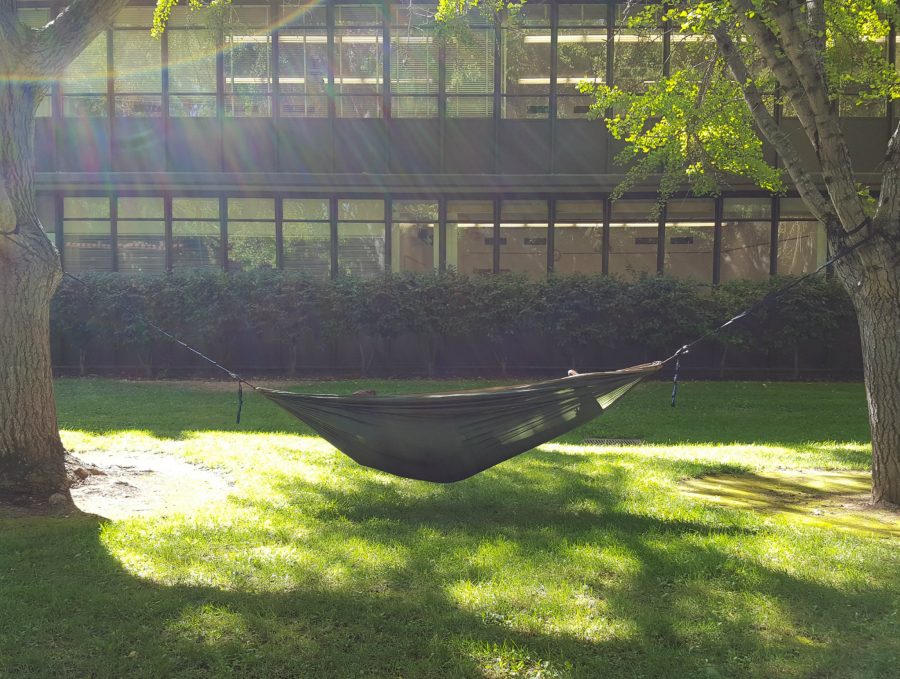MAP: Students find campus hideaways to take catnaps
Sophomore criminal justice major Matthew Smith lies on a hammock he hung between two trees in the pathway of Alpine and Calaveras halls. (Photo by Joel Boland)
May 15, 2017
(Follow the map below for specific locations)
As the semester begins to wind down, students’ stress levels heighten. During this time of the year, students tend to be tired and worn out from their busy class schedules, projects and exams.
At Sacramento State, some students can be spotted curling up in comfortable armchairs in the University Union, lying on benches outside, and even lounging in hammocks hung between two large trees in between classes.
The Union, the Library, Terminal Lounge and the AIRC are four of the most popular spots to doze off at on campus.
The third floor of the Union is relatively quiet compared to other floors, making it a comfortable environment for some students to cozy up in nearby cushioned chairs or lay down right on the floor.
Junior criminal justice major Jonathan Xiong said he frequently naps in the Union since he’s on campus two days a week to attend a total of five classes. Xiong said he naps about three times a day in between his classes so he wouldn’t doze off during lessons later.
“My class (starts) at 7:30 a.m.,” Xiong said. “I have to wake up early to come (to campus at) around 6 a.m. and find parking. I (also) sleep pretty late sometimes which makes me tired in between my other classes.”
Some people would opt for a more private option inside the Terminal Lounge, located on the second floor of the Union. Students can rent out a free room for a maximum of one hour by showing their OneCards at the front desk.
The library’s fourth floor is also a preferred spot for students to take naps. The entire floor serves as a quiet study area with individual desk cubicles lined up one after the other.
Hidden away from view by rows of bookshelves are spaces that have chairs overlooking Amador Hall through a large window. There, students can sleep on the available couches, chairs and desks.
Matthew Smith, a sophomore criminal justice major, forgoes the sturdy campus furniture and brings his own hammock to sleep in.
Smith usually sets up his hammock between Calaveras and Alpine halls where the trees are closely lined up in rows. He said relaxing in his hammock is a good way to pass the time before his next class starts.
“(Taking a nap in my hammock before class) definitely keeps me more attentive,” Smith said. “I’m relaxed and not stressed out at all.”
For junior computer science major Roselyn Duong, she’d prefer the comfort of second floor of the Union since that’s where most of her friends usually are everyday. But some days, Duong also sleeps in her car.
“I try to get six or seven hours of sleep at the very least,” Duong said. “But sometimes I can’t get that much because I have homework to do and (exams) to study for.”
Duong said that sleeping in between classes helps her feel rejuvenated, and as a result, she is able to focus better in class.
Reva Wittenberg, associate director of Campus Wellness, said that competing priorities may be the reason why students are not getting the proper eight hours of sleep nightly.
“All of our students are so busy: they’re working, they’re going to classes, they do volunteer work, they have friends to hang out with,” Wittenberg said. “I think it’s really difficult to balance it all, and sleep is probably just one of those things that wind up low on the priority list.”
She also said that a lack of sleep can impact students’ energy and their ability to think properly throughout the day —both of which can easily lead to stress.
Wittenberg encourages students to practice “sleep hygiene” in order to create good conditions for sleep — turn off electronic devices, rest at a comfortable space, meditate and avoid stimulants such as nicotine and caffeine.
According to Wittenberg, unlike longer naps that can disrupt the sleep cycle, short naps between 20 to 30 minutes can help students get through the day much easier. She noted that other universities such as UC Davis even have “nap maps” that indicate accessible spaces on campus where students can nap comfortably.
“I think if we put together a ‘nap map’, that could be really helpful for students,” Wittenberg said. “[We would be] creating safe and appropriate spaces on campus where (naps are) possible.”
RELATED: Sac State grows more than just students — serene study spots are also in bloom
Let us know in the comment section where else on campus do you like to nap at?
































































































































